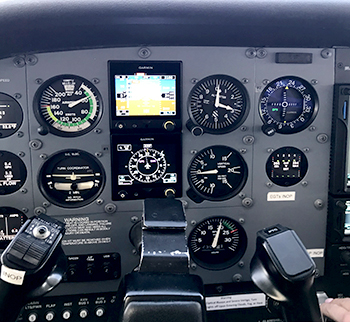Subscriber question:
"I have trouble with slow flight. It takes forever to get stabilized just where the stall horn begins to sound. I add power, then reduce power. What am I doing wrong? I’m flying a Cessna 172 if that helps." — Joe P.
Bruce:
 “Master flight maneuvers by beginning at the end. What combination of power setting, configuration, and pitch attitude gets the result you want after everything settles down? Note the RPM (and manifold pressure, if available), flap setting, and pitch attitude that sustain that condition. For slow flight in a Cessna 172, that’s typically full flaps, 2000-2100 RPM and top of the cowling just above the horizon. Note those details.
“Master flight maneuvers by beginning at the end. What combination of power setting, configuration, and pitch attitude gets the result you want after everything settles down? Note the RPM (and manifold pressure, if available), flap setting, and pitch attitude that sustain that condition. For slow flight in a Cessna 172, that’s typically full flaps, 2000-2100 RPM and top of the cowling just above the horizon. Note those details.
Here’s how you’d put that information into practice for slow flight. Assume you’re back in normal flight. Slow to about maneuvering speed as you should for all maneuvers and clear the area.
Now smoothly reduce power to about the bottom of the green arc on the RPM or manifold pressure gauge—usually about 1500 RPM. Add up-elevator pressure as necessary to maintain altitude.
Extend the first increment of flaps. Use elevator pressure as required to correct the pitch attitude and to maintain altitude as the airplane slows down. Confirm that airspeed is safely inside the white arc—the speed at which you can extend full flaps—and add the next increment of flaps.
As soon as you select that next “notch of flaps,” smoothly increase power to the RPM or manifold pressure setting that you know works for the slow flight configuration. Don’t wait for the airspeed to decrease to the final “slow flight” target speed.
Now extend full flaps. The airplane will continue to slow down. Set the pitch attitude for slow flight.
The aircraft will smoothly—but quickly—decelerate to the target airspeed. In a Cessna 172 that’s about 55 knots. With the power already set for the final result, you won’t dip below the target speed, starting a frustrating cycle of power adjustments.
The same process can quickly establish stable flight in other situations, such as flying the traffic pattern while doing touch-and-goes. As you approach pattern altitude on climbout, smoothly reduce the power to the setting you know maintains, say, 90 knots in level flight with flaps up. The airplane will stop climbing, and it will smoothly settle on altitude at the appropriate speed.
The specific power setting and pitch attitude for a given condition will vary a little between aircraft—even of the same make and model. And you’ll need to adjust for other factors, such as altitude and weight. But the predetermined power setting should get you within 10 percent of the target. You’ll only need small adjustments from that point.
And you won’t spend precious Hobbs time getting into the groove.”
When you level off at altitude, when do you set cruise power?
